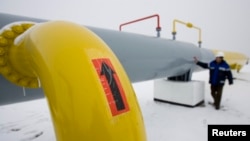The International Monetary Fund (IMF) has predicted that Uzbekistan will see 7.5 percent GDP growth this year.
A May 13 IMF press release said that "strong public investment and a strategic reorientation of gas exports from Russia to China have shielded the economy, so far, from the slowdown experienced by other countries in the region."
The "strategic reorientation of gas exports from Russia to China" is a curious statement.
It seems to imply that Tashkent chose to ship its gas to China rather than Russia. Beijing came up with a scheme to build pipelines from Turkmenistan, which has the world's fourth-largest gas reserves, to China, and the logical route for such pipelines necessarily crosses Uzbekistan's territory.
So Beijing sweetened the deal for Uzbekistan and for Kazakhstan by offering to include 10 billion cubic meters (bcm) of gas from each of those countries to add to the Turkmen gas headed for China.
Uzbekistan appeared ready to cash in on sales to both Russia and China, but it did not work out that way.
Instead, Russia has cut back on the amount of gas it purchases from Uzbekistan. Less than 10 years ago, Uzbekistan was shipping some 15 bcm to Russia; last year, Uzbekistan exported some 4.5 bcm to Russia; and this year, after Gazprom announced plans in February to cut back on Central Asian gas imports, Uzbekistan will supply 1 bcm to Russia.
But there is another problem with the IMF press release.
It is unclear how much gas Uzbekistan is supplying to China.
In 2013, Uzbekistan exported some 6 bcm to China. At the start of 2014, supplies of Uzbek gas started falling, and by May of that year, China's General Administration of Customs (GAC) said Uzbekistan had not supplied any gas to China during the month of March.
Uzbek gas exports resumed in April 2014, and Uzbek officials said the country would supply 10 bcm to China by the end of the year; but owing to the opaque nature of the Uzbek-Chinese deal, it is difficult to ascertain whether or not that was the case.
More recently, in April, Russia's nefttrans.ru cited the GAC as saying China had not imported natural gas from Uzbekistan since the start of 2015.
Additionally, Turkmenistan's Ministry of Oil and Gas said at the start of May that Ashgabat was looking to export up to 55 bcm to China this year. That is the maximum current capacity of the three pipelines running from Central Asia to China -- suggesting the three pipelines would be carrying nothing but Turkmen gas this year. (Kazakhstan is still connecting its lines to the Central Asia-China network.)
Under the best-case scenario, Uzbekistan this year would export 10 bcm to China, 1 bcm to Russia, and a far more modest amount to Kyrgyzstan. But that is likely insufficient to provide the backbone for 7.5-percent GDP growth.
-- Bruce Pannier, with contributions by Farruh Yusupov of RFE/RL's Uzbek Service






